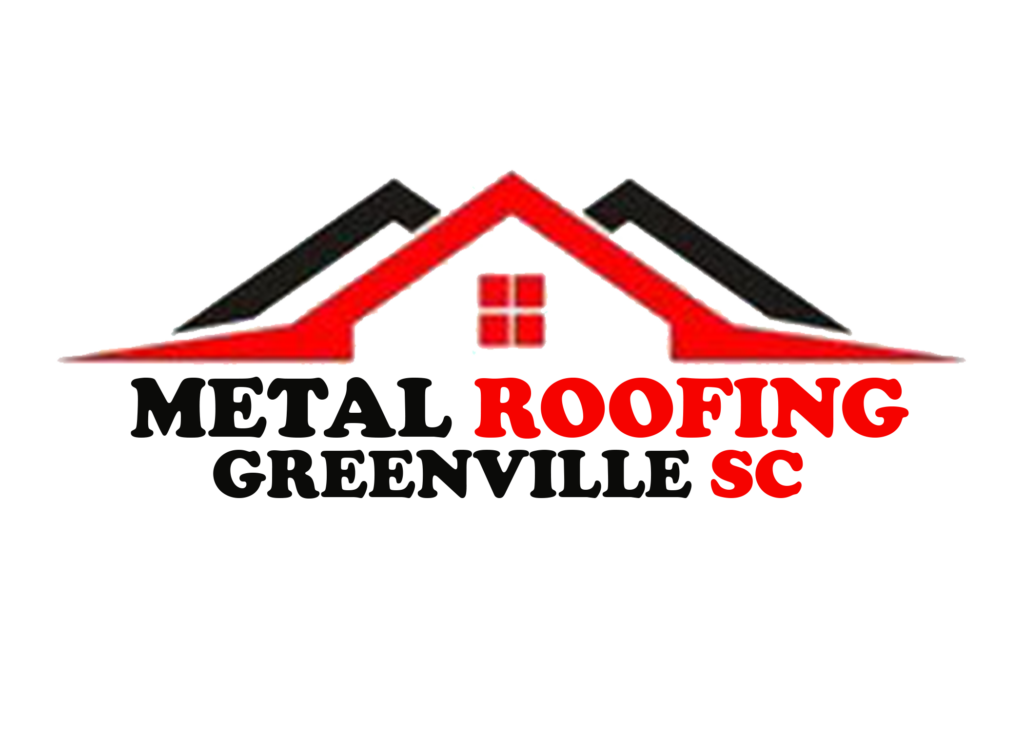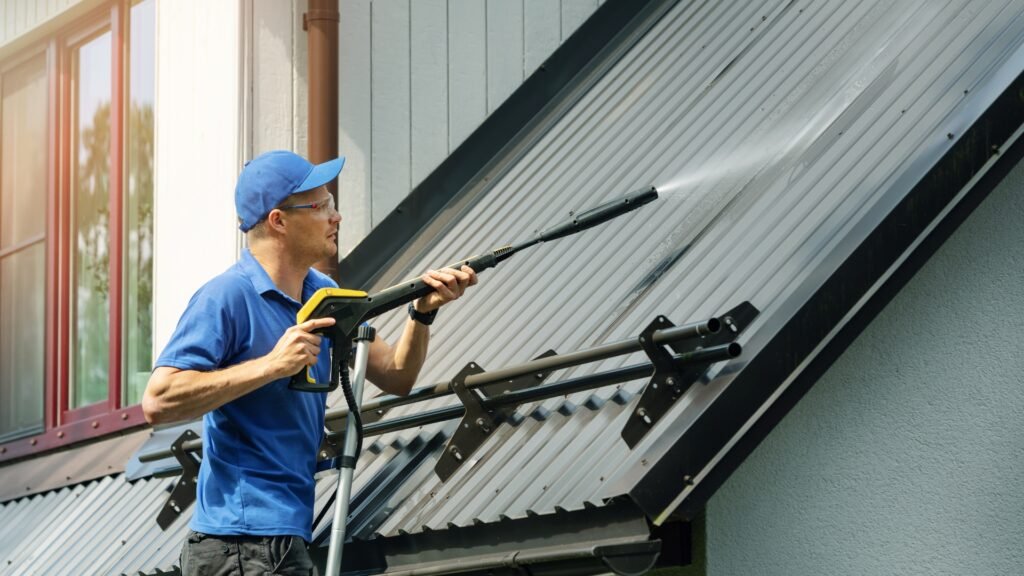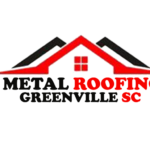A well-maintained metal roof not only enhances the aesthetic appeal of your home but also plays a crucial role in its structural integrity and energy efficiency. Regular cleaning and maintenance are essential to prolonging the lifespan of your roof and preventing costly repairs down the road.
Preparing for Roof Cleaning: Essential Steps and Safety Measures
Before you embark on cleaning your metal roof, it’s crucial to prepare adequately. This not only ensures a thorough cleaning job but also prioritizes your safety throughout the process. Follow these steps to get ready for effective roof maintenance:
1. Safety First
Safety should be your foremost concern when cleaning any roof. Ensure you have:
- Safety harness and sturdy ladder: Securely fastened to avoid accidents.
- Non-slip shoes: Provide traction on the roof’s surface.
- Weather check: Choose a dry, calm day to prevent slipping hazards.
2. Gather Your Tools and Materials
To clean your metal roof effectively, assemble the following items:
- Soft bristle brush: Ideal for removing dirt and debris without scratching the surface.
- Garden hose or pressure washer: Helps rinse off cleaning solutions and dirt.
- Non-corrosive cleaner: Specific to metal roofs to avoid damage.
3. Clear the Area
Before starting, clear the area around your home to prevent any damage from falling debris. Trim overhanging branches and remove any obstacles that could hinder your work.
4. Inspect the Roof
Take a moment to inspect your roof for any signs of damage, loose panels, or potential hazards. Address any issues before proceeding with the cleaning process to avoid exacerbating problems.
5. Plan Your Approach
Consider the layout and features of your roof. Determine the best cleaning method based on its type (e.g., corrugated, standing seam) and any specific challenges it presents.
6. Prepare Eco-Friendly Options
If you prefer eco-friendly solutions, research biodegradable cleaners or homemade remedies that are safe for your roof and the environment.
7. Dress Appropriately
Wear protective clothing, including long sleeves, pants, gloves, and eye protection, to shield yourself from chemicals and debris.
Inspecting the Roof: Key Steps for a Thorough Evaluation
Before diving into cleaning your metal roof, conduct a comprehensive inspection to identify any potential issues that may require attention. This proactive approach not only ensures effective cleaning but also helps prevent future damage. Follow these essential steps to inspect your roof thoroughly:
1. Check for Damage
Inspect the entire surface of your metal roof for signs of damage such as:
- Dents or dings: Often caused by hail or falling branches.
- Loose or missing panels: Secure loose panels and replace any missing ones promptly.
- Rust or corrosion: Address rust spots promptly to prevent further deterioration.
2. Assess Sealant and Coatings
Evaluate the condition of any sealants or protective coatings applied to your roof:
- Inspect seams and joints: Look for cracks or gaps where water could penetrate.
- Check for peeling or deterioration: Reapply sealant as needed to maintain waterproofing.
3. Clear Debris and Blockages
Remove any debris such as leaves, branches, or dirt that may have accumulated on your roof or in gutters:
- Clean gutters and downspouts: Ensure proper drainage to prevent water buildup.
- Clear vents and chimneys: Remove debris to maintain ventilation and prevent fire hazards.
4. Look for Signs of Wear and Aging
Examine areas that are prone to wear and aging:
- Inspect flashing: Ensure flashing around chimneys, skylights, and vents is intact and sealed.
- Check for discoloration: Address discoloration, which may indicate underlying issues such as algae growth or oxidation.
Choosing the Right Cleaning Method for Your Metal Roof
Selecting the appropriate cleaning method is essential to effectively remove dirt, debris, and contaminants from your metal roof without causing damage. Consider these factors to determine the best approach for cleaning your roof:
1. Consider Your Roof Type
Different types of metal roofs (e.g., corrugated, standing seam) may require specific cleaning methods:
- Corrugated metal roofs: Often benefit from gentle cleaning methods to avoid damaging ridges.
- Standing seam metal roofs: Require careful attention to preserve sealants and coatings on seams.
2. Assess the Level of Cleaning Needed
Evaluate the extent of dirt, debris, and stains on your roof to determine the appropriate cleaning intensity:
- Light cleaning: Suitable for routine maintenance to remove dust and light debris.
- Moderate cleaning: Involves using mild cleaners to remove stains and algae.
- Heavy-duty cleaning: Requires stronger cleaners or professional assistance for stubborn stains and heavy debris buildup.
3. Eco-Friendly Options
Explore environmentally friendly cleaning solutions and methods:
- Biodegradable cleaners: Safe for your roof and surrounding environment.
- DIY cleaning solutions: Using household items like vinegar or mild soap can be effective and eco-friendly.
4. Avoid Harsh Chemicals
To protect your roof and the environment, avoid using harsh chemicals or abrasive materials that can damage the metal or strip protective coatings.
5. Consult Manufacturer Guidelines
Refer to the manufacturer’s recommendations for cleaning and maintaining your specific type of metal roof. Following these guidelines ensures you use products and methods that are safe and effective for your roof’s material.
Step-by-Step Cleaning Process for Your Metal Roof
Follow these detailed steps to effectively clean your metal roof and restore its appearance while maintaining its structural integrity:
1. Clear Debris
Begin by clearing any loose debris such as leaves, branches, and dirt from the roof’s surface and gutters:
- Use a leaf blower or soft-bristled brush: Safely remove debris without damaging the roof.
2. Wet the Roof Surface
Thoroughly wet the entire roof surface using a garden hose or pressure washer with a gentle spray setting:
- Start from the top: Work your way down to ensure even coverage and prevent streaking.
3. Apply Cleaning Solution
Choose a suitable cleaning solution based on the level of cleaning required and your roof’s material:
- Mix according to manufacturer’s instructions: Use a mild detergent, biodegradable cleaner, or a solution recommended for metal roofs.
4. Scrub Gently
Using a soft-bristled brush or mop, scrub the roof surface in sections:
- Work from top to bottom: Remove stains and dirt while avoiding abrasive scrubbing that could damage the metal.
5. Rinse Thoroughly
After scrubbing each section, rinse thoroughly with clean water:
- Use a garden hose or pressure washer: Ensure all cleaning solution and debris are washed away.
6. Repeat if Necessary
For stubborn stains or heavily soiled areas, repeat the cleaning process as needed:
- Adjust cleaning solution concentration: Increase strength slightly if stains persist, but avoid harsh chemicals.
7. Inspect and Dry
Inspect the roof surface for any missed spots or lingering debris:
- Allow the roof to dry completely: Check for proper drainage and clear any remaining debris from gutters and downspouts.
8. Apply Protective Coating (Optional)
Consider applying a protective coating or sealant to enhance the roof’s durability and resistance to future stains:
- Follow manufacturer’s instructions: Apply evenly and allow adequate drying time.
Dealing with Stubborn Stains or Mold on Your Metal Roof
When cleaning your metal roof, you may encounter stubborn stains or mold that require targeted treatment. Follow these steps to effectively address these issues while preserving your roof’s integrity:
1. Identify the Stains or Mold
Carefully inspect your roof to identify areas with stubborn stains, mold, or mildew:
- Common issues: Rust stains, algae growth, or discoloration due to environmental factors.
2. Choose the Right Treatment
Select an appropriate treatment method based on the type of stain or growth:
- Rust stains: Use a rust remover specifically formulated for metal surfaces.
- Algae or mold: Apply a mildew remover or a solution of water and vinegar.
3. Apply the Treatment
Follow these steps to apply the treatment safely and effectively:
- Read instructions: Follow manufacturer’s guidelines for application and safety precautions.
- Use a soft brush: Gently scrub the affected area to loosen stains or growth.
4. Rinse Thoroughly
After applying the treatment, rinse the area thoroughly with clean water:
- Avoid leaving residues: Ensure all cleaning solution and loosened debris are washed away.
5. Prevent Future Growth
Take preventive measures to reduce the likelihood of stains or mold returning:
- Improve roof ventilation: Ensure adequate airflow to inhibit mold and algae growth.
- Trim nearby trees: Reduce shade and debris accumulation on the roof.
6. Monitor and Maintain
Regularly inspect your roof for signs of recurring stains or growth:
- Address promptly: Treat any new stains or growth promptly to prevent further damage
Preventative Measures and Maintenance Tips for Your Metal Roof
Maintaining the cleanliness and integrity of your metal roof is essential for its longevity and performance. Follow these preventative measures and maintenance tips to keep your roof in optimal condition:
Regular Inspections: Conduct routine inspections to identify potential issues before they escalate, ensuring timely repairs and maintenance.
Clear Debris: Remove leaves, branches, and other debris regularly to prevent clogged gutters and water pooling.
Apply Protective Coatings: Consider applying a protective coating or sealant to enhance durability and resistance to environmental factors.
Address Rust Promptly: Treat any signs of rust promptly using appropriate rust removers or preventive coatings.
Monitor Sealants and Flashing: Check sealants and flashing around vents, chimneys, and skylights for cracks or deterioration, repairing or replacing as needed.
Promote Ventilation: Ensure adequate roof ventilation to reduce moisture buildup and prevent mold and mildew growth.
Professional Maintenance: Schedule professional inspections and maintenance periodically to address any issues and ensure your roof’s longevity.
By following these preventative measures and maintenance tips, you can prolong the lifespan of your metal roof and maintain its appearance and functionality for years to come.
Safety Considerations When Cleaning Your Metal Roof
Ensuring safety during the cleaning process is paramount to protect yourself, your property, and the structural integrity of your roof. Follow these essential safety considerations when cleaning your metal roof:
Safety Gear: Wear appropriate safety gear including non-slip shoes, gloves, eye protection, and a safety harness if working at heights.
Sturdy Ladder: Use a sturdy, well-positioned ladder that extends at least 3 feet above the roof edge for safe access.
Weather Conditions: Choose a dry, calm day to minimize slipping hazards and ensure optimal working conditions.
Avoid Pressure Washing: Unless recommended by the manufacturer, avoid using high-pressure washers that can damage metal roofing and void warranties.
Chemical Safety: Use cleaning solutions and chemicals according to manufacturer instructions, wearing protective clothing and avoiding direct contact with skin and eyes.
Bystander Safety: Keep bystanders and pets away from the work area to prevent accidents and injuries.
Emergency Plan: Have an emergency plan in place, including access to a first aid kit and a means of communication in case of accidents.
By prioritizing safety during roof cleaning, you can effectively maintain your metal roof while minimizing risks to yourself and others.
Final Checks and Post-Cleaning Care for Your Metal Roof
Completing thorough final checks and post-cleaning care is crucial to ensuring your metal roof remains in optimal condition after cleaning. Follow these steps to wrap up your cleaning process effectively:
Inspect for Missed Spots: Walk the entire roof surface to check for any missed spots or areas that may require additional cleaning or treatment.
Clear Gutters and Downspouts: Ensure gutters and downspouts are clear of debris to prevent water buildup and potential damage to your roof and home.
Check for Damage: Reassess the roof for any new damage or issues that may have arisen during the cleaning process, such as loose panels or damaged sealants.
Address Repairs Promptly: Take note of any repairs needed and address them promptly to prevent further damage and maintain the integrity of your roof.
Apply Protective Coating (Optional): Consider applying a protective coating or sealant to enhance your roof’s durability and resistance to future stains and damage.
Monitor Post-Cleaning: Keep an eye on your roof in the weeks following cleaning to ensure it remains in good condition and address any unexpected issues promptly.
By completing these final checks and post-cleaning care steps, you can maintain the cleanliness, integrity, and longevity of your metal roof for years to come.
Conclusion: Maintaining Your Metal Roof for Longevity and Beauty
Regular maintenance and proper cleaning are essential for preserving the beauty and functionality of your metal roof. By following the steps outlined in this guide, you can effectively clean your roof, address potential issues, and ensure it remains in excellent condition for years to come.
Benefits of Regular Maintenance: Cleaning your metal roof not only enhances its curb appeal but also extends its lifespan by preventing corrosion, mold growth, and structural damage. A well-maintained roof contributes to the overall energy efficiency and value of your home.
Environmental Considerations: Opt for eco-friendly cleaning solutions and methods whenever possible to minimize environmental impact while maintaining the integrity of your roof.
Safety First: Prioritize safety throughout the cleaning process by using proper safety gear, following manufacturer guidelines for cleaning solutions, and choosing optimal weather conditions.
By incorporating these practices into your roof maintenance routine, you not only protect your investment but also ensure your home looks its best year-round.


